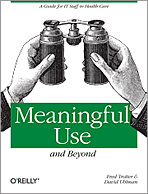Have you had an auto mechanic look at your wrecked car and sigh, “they just don’t make them like they used to”?
Darn right they don’t make them like they used to. Old cars were much better about surviving wrecks, but at the expense of the occupants. Modern cars might seem “flimsy” compared to old cars, but that “flimsiness” is due to highly engineered “crumple zones” that ensure that in a wreck, the car takes the energy rather than your body. Thank the gods that cars have changed.
But notice that a superficial examination of highly engineered cars makes them seem worse. They appear to fail by being so “flimsy,” relative to earlier, immature designs. In reality the fact that your car is super-sensitive to outside forces is a critical safety feature.
Along similar lines, we need to recognize highly engineered health information systems and embrace features that really impact patient safety. This is true of all critical software systems, not just health IT. But health IT is a great place to find ugly-but-highly-functional software.
One constant criticism of VA VistA (and its many derivatives), which is either the most highly engineered EHR software in the world or damn close, is that it is not “user-friendly enough.” Other mature solutions — Epic, et al. — get the same treatment.
Often, clinicians encounter a software process that takes five steps when they believe it should only take one. Sometimes that’s clearly due to a design flaw. Sometimes, however, it’s a crumple zone. Sometimes those extra “steps” exist because the software engineers had to put 50 extra workflow “paths” into a process that a clinician sees as “simple” so that they could check, and double check, for all kinds of rare cases.
The design of old cars is frozen, but the design of old software is not. Software that is continuously developed over a long period of time is the embodiment of "highly engineered."
You can understand why people like me get a little sea sick when we hear about someone releasing EHR software that runs on an iPad. That seems like a really great idea until you realize how many things they might not have thought of. It’s very much like you might feel if someone told you that they were releasing a three-wheeled car. A three-wheeled car, like any iPad application, might be great, or the new engineering substrate might introduce new types of problems that neither the clinicians nor the software designers could predict. More than likely, it will be great and introduce new unforeseen errors.
Don’t get me wrong — I think tablet-based interfaces to EHR systems are a great idea. But no one should be taking it for granted that an input-limited device like that will always be safe. Think of the implications of touchscreens plus bacteria/virus transfer alone! That doesn’t mean it’s not a great idea, but we certainly should not assume that it’s a great idea.
 Meaningful Use and Beyond: A Guide for IT Staff in Health Care — Meaningful Use underlies a major federal incentives program for medical offices and hospitals that pays doctors and clinicians to move to electronic health records (EHR). This book is a rosetta stone for the IT implementer who wants to help organizations harness EHR systems.
Meaningful Use and Beyond: A Guide for IT Staff in Health Care — Meaningful Use underlies a major federal incentives program for medical offices and hospitals that pays doctors and clinicians to move to electronic health records (EHR). This book is a rosetta stone for the IT implementer who wants to help organizations harness EHR systems.Related:
